| Back OpEd News | |||||||
|
Original Content at https://www.opednews.com/articles/Why-Were-the-WTC-Twin-Towe-by-Wayne-Coste-Demolition_Evidence_Explosives_Tower7-200325-537.html (Note: You can view every article as one long page if you sign up as an Advocate Member, or higher). |
|||||||
March 24, 2020
Why Were the WTC Twin Towers Destroyed That Way: Explaining the Mechanism of Their Destruction on 9/11
By Wayne Coste
One of the unanswered questions about the events of September 11, 2001, is why the Twin Towers were destroyed in such an energetically outward manner. The primary reason for this mode of demolition was the ability to exploit the structural weakness of the floor truss to channel connection requiring the breaking of a limited number of 5/8" bolts per floor. A nano-thermite propellant could have provided the needed outward force.
::::::::
One of the unanswered questions about the events of September 11, 2001, is why the Twin Towers were destroyed in such an energetically outward manner. The destruction was neither typical of a fire-related, gravity-driven collapse nor of a controlled demolition using pre-planted explosives. The mechanism employed has baffled researchers since 9/11. A new paper, "Investigating the Mechanics of Destruction at the Twin Towers on 9/11: The Case for Propelled Demolition", proposes a method for the destruction of the Twin Towers that is in agreement with the construction of the Twin Towers, as well as key observations about its destruction.
The National Institute of Standards and Technology (NIST) was tasked with explaining the destruction of the Twin Towers (WTC 1 and WTC 2) and Building 7 (WTC 7). In spite of the mandate, NIST's analysis focused on the structural response of the building elements, but did not attempt to explain the actual destruction.
Because of NIST's abdication of an official explanation for the observed destruction, over the last 19 years conjecture has focused on the use of "explosive detonations". However, there is scant evidence in the audio record for the use of traditional high-explosive detonations (e.g., molecular explosives). Furthermore, the structural remnants including steel beams, columns and connections do not exhibit a widespread pattern of damage to support "explosive detonations" as a significant factor.
For much of the buildings' destruction, the observations show a highly energetic propelling force that was activated floor-by-floor with the origin of this force centered at the buildings' core / elevator shafts and radiating outward in the north-south-east and west directions. This observed propelling force is hypothesized to be based on a nano-thermite material that was "tuned" to be more like a rocket fuel than either an explosive or an incendiary. This type of material would be more explosive than a propellant and not as explosive as "molecular" or high explosives.
The activation of this propellant would create forces that traveled across the office areas in a very high-temperature thermal stream that would have been hot enough to contain molten iron that would later cool into iron spheres. The effect of the passage of such an energetic stream on office contents, humans, and asbestos fireproofing would be to dissociate virtually everything encountered. The propellant-derived forces would have accelerated the office furnishings and even floor-truss components toward the perimeter column sections, creating immense simultaneous outward forces that the building was not designed to withstand. These forces resulted in the separation of the structure at its weakest point, which was the interior bolted connections between the floor trusses and the steel "channels" along the outside of the core.
The outer-perimeter wall sections were then propelled outward and peeled downward and outward through most of the height of the towers. This mechanism would have progressed down the structure at a relatively constant rate optimized by mechanically determined parameters using, and leveraging, gravitational forces.
Floor-Truss Connections
The connection of the floor trusses to the core was via two 5/8-inch bolts per truss at a channel. The connection of the floor truss to the outer-perimeter column was more substantial and included a welded gusset plate, a lower damper connection, and bracing to either side for stability. Figure 1 shows a diagram of the floor-truss connections, and Figure 2 shows the post-demolition channel seats that were analyzed by NIST.
To separate the office area from the core would have required the destruction of only 28 5/8-inch bolts on the short side of the core and 40 bolts on the longer side. It appears that because of this weakness, the propelled demolition described above was used instead of a more traditional process that would have been consistent with the (officially endorsed) "Bazant's pile-driver" theory.
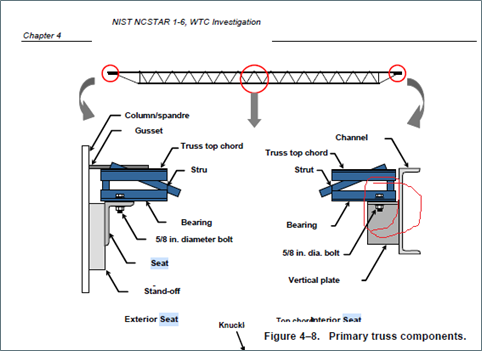
Comparison of floor truss connections to core and perimeter columns.
(Image by NIST: WTC Disaster Study (NCSTAR1-6)) Details DMCA
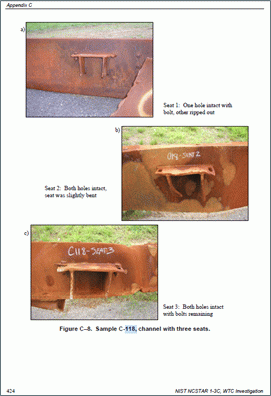
Truss seat connections on channel steel piece identified as NIST C-118.
(Image by NIST: WTC Disaster Study (NCSTAR1-6)) Details DMCA
Details of the Propelled-Demolition Hypothesis
The propelled-demolition hypothesis assumes that initiation began at the elevation of the plane impact and proceeded both upward and downward from this location. Once initiation began, the sequence proceeded upward in the floors above the impact point and downward below it.
As shown by the red arrows in Figure 3, the propellant was activated at the core and propelled in all directions simultaneously. The perimeter columns around the outside of each floor would all be pushed outward simultaneously, which matches the observations. In accordance with Newton's third law, "for every action, there is an equal and opposite reaction", the propulsive force to push the exterior-perimeter columns outward must be created by an equal "reactionary" force in the opposite direction such as into the region of the core columns and then out through the opposite side of the Tower.
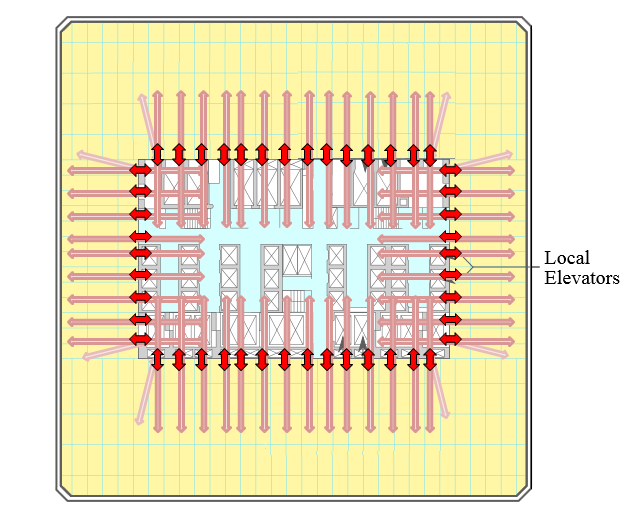
Ignition of propellant at each floor level pushes the perimeter columns outward and creates a reactionary force into the core columns and out through the opposite side.
(Image by MesserWoland, Author: MesserWoland) Details Source DMCA
These outward forces caused the separation of the floor trusses at the channel at the bolted connections and accelerated the concrete floor outward and away from the core. After the initial perimeter columns were pushed outward, the leaning-out-of-alignment columns would then add to the outward tensile forces at the bolted connections. The propelling process then progressed at a constant rate down the structure. This process could be described "like an unzipping of the building" all the way down, similar to peeling a banana.
The sequence of the "banana-peeling" mechanism is illustrated in the series of images from Figure 4 through Figure 9. Figure 4 illustrates a six-floor segment before the demolition begins. The floor trusses traverse the area from channel seats (yellow columns) to the outside seats at the perimeter column (green). An interior core column and supporting cross members are also shown in Figure 4 (orange). The floors are identified as A through F for convenience.
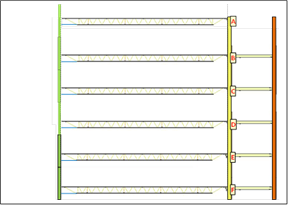
Structure showing floor trusses on six floors — from the perimeter columns to an interior core column.
(Image by Wayne Coste, PE) Details DMCA
In Figure 5, the propellant has been activated above floor "A" and is exerting outward pressure on perimeter columns. This puts tension on the bolted connections at both ends of the floor truss. Then the propellant between floors "A" and "B" is activated. Some amount of propellant and associated debris would be ejected through the windows creating a debris cloud, such as was observed around each floor.
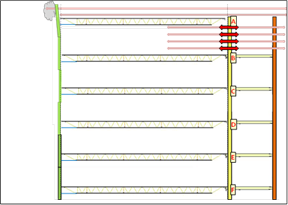
With channel connection at 'A' separating due to tension from events on the floor above, high temperature propellant accelerates toward perimeter wall through the office contents,scouring the floor truss structure.
(Image by Wayne Coste, PE) Details DMCA
Figure 6 shows the continued activation of the propellant between floors "B" and "C". At this stage the perimeter columns are leaning outward.
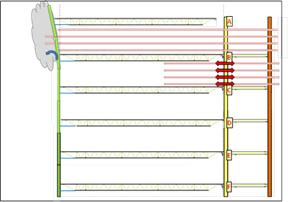
With connections at 'A' and 'B' separating due to the momentum impact of the propellant and accelerated office contents against the perimeter wall, the separation at connection 'C' begins.
(Image by Wayne Coste, PE) Details DMCA
Figure 7 shows the progression down the building with the activation of the propellant between floors "C" and "D". The outer-perimeter columns continue to lean outward and will eventually separate and fall away with some outward horizontal velocity. The perimeter columns are three-story-high sections that are staggered to provide multi-floor stability. Depending on where the perimeter column sections were joined, they could exert an enhanced outward force based on the principles of a cantilever. With the bolted connection broken between the channel and the floor truss, Floor "A" near the core is unsupported and begins to fall towards Floor "B".
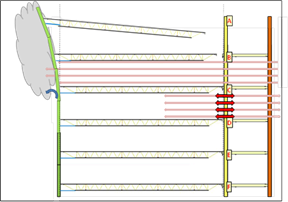
With connections at 'A,' 'B' and 'C' separating due to the momentum impact of the propellant and accelerated office contents against the perimeter wall, the separation at connection 'D' begins.
(Image by Wayne Coste, PE) Details DMCA
Figure 8 shows the continued progression of the demolition down the building with the activation of the propellant between floors "D" and "E". Floor "B" near the core is unsupported and begins to fall towards Floor "C".

With connections at 'A,' 'B,' 'C,' and 'D' separating due to the momentum impact of the propellant and accelerated office contents against the perimeter wall, the separation at connection 'E' begins.
(Image by Wayne Coste, PE) Details DMCA
Figure 9 shows the same conditions as Figure 8 but also includes the opposite side of the tower to illustrate the reactionary forces. The orange arrows represent the reactive forces, which are a necessary result of the propellant force. As shown in the top group of orange arrows, the propellant traversing across the core will not be constrained between upper and lower floors and will be directed upward as the stream continues outside the tower on the opposite side. This upward direction of the reactionary propellant would provide an observable feature during the destruction in the form of "rooster-tails".

Newtonian reactionary forces (orange arrows) travel in the opposite direction across the core into, and above, the collapsing structure to create the observed 'Rooster Tails.'
(Image by Wayne Coste, PE) Details DMCA
As shown in Figure 10, the directionality of the propulsive forces and "rooster-tail" hypothesized in this scenario match the observations captured in aerial photos of the destruction of the North Tower.
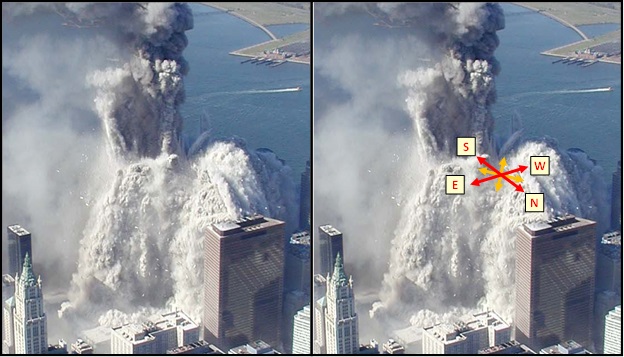
The majority of the propulsive forces in the cardinal directions creating 'rooster tails' with significantly less propulsion in the ordinal directions.
(Image by Detective Greg Semendinger, N.Y.P.D.) Details DMCA
The paper covers this mechanism in more detail. It also describes the mechanics behind a number of other aspects of the destruction of the Twin Towers.
Authors Website: http://www.scientistsfor911truth.com/wayne-h-coste
Authors Bio:
Licensed Professional Engineer dealing with energy issues. Active in promoting the ethics of the engineering profession.